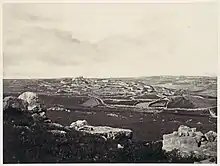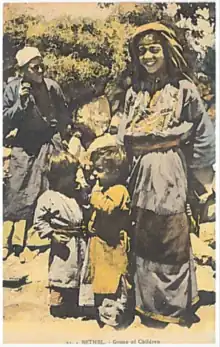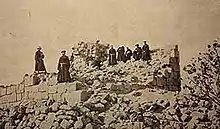Beitin | |
|---|---|
| Arabic transcription(s) | |
| • Arabic | بيتين |
| • Latin | Baytin (official) Bittin (unofficial) |
 Beitin, late 19th century, by Felix Bonfils | |
 Beitin Location of Beitin within Palestine | |
| Coordinates: 31°55′42″N 35°14′18″E / 31.92833°N 35.23833°E | |
| Palestine grid | 172/148 |
| State | State of Palestine |
| Governorate | Ramallah and al-Bireh |
| Founded | Early 19th century |
| Government | |
| • Type | Village council (from 1996) |
| • Head of Municipality | DIAB YASIN |
| Area | |
| • Total | 4,764 dunams (4.8 km2 or 1.9 sq mi) |
| Population (2017)[1] | |
| • Total | 2,242 |
| • Density | 470/km2 (1,200/sq mi) |
| 5k | |
| house of faith | corruption of the Hebrew "Bethel",[2] house ("beth" or "beit") of God ("el")[3] |
Beitin (Arabic: بيتين, romanized: Baytīn) is a Palestinian village in the Ramallah and al-Bireh Governorate in the central West Bank, located 5 kilometers (3.1 mi) northeast of Ramallah along the Ramallah-Nablus road. The Palestinian village of Dura al-Qar' and Ein Yabrud lie to the north, Rammun to the east, Deir Dibwan to the southeast and al-Bireh to the southwest. The Israeli settlement of Beit El is northwest of Beitin.
Geography
There are several springs around Beitin, which is known for its olive, almond, fig and plum groves.[4]
History
Periods of settlement
Beitin is identified with the ancient village of Bethel, and preserves its ancient name. Bethel was mentioned in the Hebrew Bible, 1 Maccabees, Josephus' writings, and in several patristic texts.[5]
The site was first settled during the Chalcolithic period. Sherds from the Early, Intermediate, Middle and Late Bronze Age, as well as the Iron Age I and II, the Persian, Hellenistic, Roman,[6] the Byzantine[6][7] and Crusader/Ayyubid periods have been found.[6] At the ruins of the Crusader watchtower (al-Burj), residential remains from the Mamluk period were discovered.[8]
The village was abandoned after the 1187 defeat of the Crusaders at the hands of Saladin and the ensuing destruction of Christian sites. The village was only reestablished in the 19th century under Ottoman rule.
Chalcolithic period
Human settlement at the site of Beitin dates back to the Chalcolithic period. Archaeological excavations in 1950 uncovered flint tools, pottery and animal bones from that time.
Bronze Age
In the Early Bronze Age (around 3200 BCE) normally nomadic populations settled in the area. Canaanite tombs, houses and olive presses were discovered to the north and southeast of the village. The remains of a Canaanite temple were also excavated by archaeologists.[9]
In the Middle Bronze Age (around 1750 BCE) its status was elevated from a village to a fortified Canaanite town which is believed to be biblical Luz.[4][10] Two city gates dating to this period have been excavated, one in the northeast and the other northwest of the wall.[9] A second temple was built in Luz during this period, but was destroyed as a result of an earthquake.[9]
Iron Age
Biblical reference
Beitin has been identified as the biblical Bethel,[11] the site where Jacob slept and dreamt of the angels coming up and down a ladder (Genesis 28:19).[12] Some scholars believe that Bethel was located on the site of the ruins surrounding Beitin.[13] According to Genesis, Jacob encountered God near Luz and renamed the place Bethel or "House of God." However, based on the biblical Book of Joshua (Joshua 16:2), which says mibBeit-el Luzah ("from Bethel to Luz"), Luz and Bethel may have been two different places.[10]
Roman and Byzantine periods
Bethel was garrisoned by Bacchides (during the Maccabean revolt) and later by Vespasian (during the First Jewish–Roman War).[5] In Byzantine times, Bethel held annual festivals on October 18. The population was Eastern Orthodox Christian and monks from the Sinai Peninsula, particularly Zosimas of Palestine, were known to have visited the town.[10] A church dating from the fifth century CE was found at the site.[5]
Early Muslim period
The church fell into ruin after the Islamic Rashidun army conquered the area.[10]
Crusader & Ayyubid periods
The church was rebuilt by the Crusaders in the 12th century.[10] During the Crusader period, the village was given as fief by Baldwin V of Jerusalem to the Church of the Holy Sepulchre.[14] After the Crusaders were defeated by the Ayyubid forces of Saladin in 1187, the church was destroyed and the village was abandoned.[10]
Ottoman period

The region had been part of the Ottoman Empire since 1517 and after Beitin was reestablished, the village came under the administration of the Mutasarrif ("Governorate") of Jerusalem.[15] In the early 19th century, people from Transjordan and other places migrated to Beitin[10][16] and built a mosque near the site of the old church.[17]
In 1838 Edward Robinson noted Beitin as a place "in ruins or deserted," located immediately north of Jerusalem.[11][18]
In 1863 Victor Guérin found the village to have 400 inhabitants,[19] while an Ottoman village list from around 1870 showed that Beitin had an adult male population of 140, in a total of 55 houses (thus excluding women and children).[20][21]
In 1882 the PEF's Survey of Western Palestine described Beitin as a village "built on the side of a flat spur which rises slightly on the north. On the south-east is a flat dell, with good fig and pomegranate gardens, and there are other fig-trees round the village and among the houses. The cottages have a ruinous appearance, with rough stone walls. There is one square white house in two stories, which is visible from a great distance. The ground is very open, and the slopes gentle; the village slopes down gradually south-east. The surrounding ground is quite bare of trees, of white chalk, very barren and stony on the south; of hard limestone cropping up on the north; the fields divided off by low drystone walls. The contrast of the grey rocks, the red ploughland and the dark green figs is very striking. The remains of a good-sized tower exist towards the north, and on the south the walls of a church of Crusading date, once dedicated to St. Joseph. The population is stated at 400. The place is supplied from a fine spring on the south, which wells up in a circular basin. The spring is double, and was surrounded with a large reservoir, 314 feet long north-west and south-east, by 217 feet; of massive stones. The eastern and southern walls are standing about 10 feet high. The spring is perennial..."[22]
In 1896 the population of Betin was estimated to be about 360 persons.[23]
In 1907, small gardens and a few old tombs were found in the vicinity, and the Muslim population was known for its strength and fearlessness.[24]
British Mandate period

In the 1922 census of Palestine conducted by the British Mandate authorities, Baitin had a population of 446; all Muslims,[25] increasing at the time of the 1931 census to 566, still all Muslim, in 135 houses.[26]
In the 1945 statistics the population was 690 Muslims,[27] while the total land area was 4,764 dunams, according to an official land and population survey.[28] Of this, 1,348 were allocated for plantations and irrigable land, 1,853 for cereals,[29] while 38 dunams were classified as built-up areas.[30]
Jordanian period
In the wake of the 1948 Arab–Israeli War, and after the 1949 Armistice Agreements, Beitin came under Jordanian rule.
In 1961, a Jordanian census found the population to be 1,017.[31]
Post-1967
After the Six-Day War in 1967, Beitin has, with the rest of the West Bank, been held under Israeli occupation. The population in the 1967 census conducted by the Israeli authorities was 958, of whom 134 originated from the Israeli territory.[32]
After the 1995 accords, 19,1% of the village land is classified as Area B, while the remaining 80.9% is defined as Area C land (full Israeli control). Beitin village land has also been taken in order to construct the illegal Israeli outpost Givat Asaf.[33][34]
On 19 December 2011, Israeli settlers were accused of carrying out a second price tag attack in only four days, in which five Palestinian-owned cars were burnt and the walls of several houses were sprayed with graffiti.[35] During the first incident (15 December 2011), the assailants not only vandalized a mosque, but also attacked an IDF military base in the West Bank, injuring a top Israeli commander.[36] According to witnesses of the second incident, the Israeli army dispersed the settlers without arresting any of them,[35] presumably also those who attacked the Israeli commander, although four days earlier the incident had prompted Israeli Prime-Minister, Benjamin Netanyahu, to say: "We won't let them attack our soldiers. We won't let them ignite a religious war with our neighbors. We won't let them desecrate mosques. We won't let them harm Jews or Arabs."[36]
Landmarks
Church ruins
The ruins of the Byzantine church are known in Arabic as "al-Muqater" or "Khirbet al-Kenise" ("Ruins of the Church").[10][37] According to Röhricht, when the Crusaders arrived, they found a ruined church. They built another and placed it first under the Abbey of St. Joseph of Arimathea, later under the Canons of the Holy Sepulcher.[10][38] The ruins of the church were drawn in the 1880s.[39][40]
Tower ruins ("al-Burj")

Another ruin, called "al-Burj Beitin" ("the Tower of Beitin") or simply al-Burj is located in the western part of the village.[10] They were also drawn in the 1880s.[41] The ruins of the Burj are about 1 meter tall, and apparently built on the older ruins of a Byzantine monastery.[42] Some have believed that it was constructed on the site where Abraham built an altar.[17][43] According to biblical scholar Edward Robinson who visited Palestine in the 19th century, al-Burj Beitin consisted of dilapidated stones that used to form part of a fortress and a Greek church.[11] Al-Burj was used as a watch tower by the Crusaders.[10]
Demographics

In 1997, Palestinian refugees accounted for exactly 30% of the population, which was 1,510 at the time.[44]
According to the Palestinian Central Bureau of Statistics (PCBS), Beitin had a population of over 3,050 inhabitants in 2006.[45] In 2007, a PCBS census recorded a population of 2,143 (1,128 men and 1,015 women). There were 717 homes in the village and the average household size consisted of 4.9 family members.[46]
References
- ↑ "Main Indicators by Type of Locality - Population, Housing and Establishments Census 2017" (PDF). Palestinian Central Bureau of Statistics (PCBS). Retrieved 2021-01-19.
- ↑ Palmer, 1881, p. 226
- ↑ Robinson and Smith, 1841, vol 2, pp. 128 -129
- 1 2 "Palestinian Cultural Sites: Beitin-Ramallah". Jerusalem Media and Communications Center (JMCC). Archived from the original on 2007-03-10. Retrieved 2011-12-19.
- 1 2 3 Avi-Yonah, Michael (1976). "Gazetteer of Roman Palestine". Qedem. 5: 38. ISSN 0333-5844.
- 1 2 3 Finkelstein and Lederman, 1997, p. 518
- ↑ Dauphin, 1998, p. 835
- ↑ Keio University, Archaeological Excavations and Development of Resources for Tourism at Beitin (Bethel), website of the Japan Consortium for International Cooperation in Cultural Heritage Independent Administrative Instituti. Accessed 15 April 2019.
- 1 2 3 "Site of the Week: Beitin". This Week in Palestine. 2007-07-09. Archived from the original on 2012-04-26. Retrieved 2011-12-19.
- 1 2 3 4 5 6 7 8 9 10 11 Luza, also Bethel - (Beitin) Archived 2013-10-03 at the Wayback Machine Studium Biblicum Franciscanum - Jerusalem. 2000-12-19.
- 1 2 3 Robinson and Smith, 1841, vol. 2, pp. 125-130.
- ↑ Easton, 1893, p. 94
- ↑ Trisdam, 1865, pp. 164-166
- ↑ Conder and Kitchener, 1883, SWP III, p. 11
- ↑ "Palestinian Places: Beitin". Jerusalem Media and Communications Center (JMCC). Retrieved 2011-12-19.
- ↑ Lutfiyya, 1966, p. 36
- 1 2 Visit Palestine: Bittin Visit Palestine.
- ↑ Robinson and Smith, 1841, vol 3, Appendix 2, p. 122
- ↑ Guérin, 1869, pp. 14-26
- ↑ Socin, 1879, p. 148. It was noted in the Bire District
- ↑ Hartmann, 1883, p. 127 also noted 55 houses
- ↑ Conder and Kitchener, 1882, SWP II, pp. 295-296
- ↑ Schick, 1896, p. 121
- ↑ Grant, 1907, p. 218
- ↑ Barron, 1923, Table VII, Sub-district of Ramallah, p. 16
- ↑ Mills, 1932, p. 47
- ↑ Government of Palestine, Department of Statistics, 1945, p. 26
- ↑ Government of Palestine, Department of Statistics. Village Statistics, April, 1945. Quoted in Hadawi, 1970, p. 64
- ↑ Government of Palestine, Department of Statistics. Village Statistics, April, 1945. Quoted in Hadawi, 1970, p. 111
- ↑ Government of Palestine, Department of Statistics. Village Statistics, April, 1945. Quoted in Hadawi, 1970, p. 161
- ↑ Government of Jordan, Department of Statistics, 1964, p. 24 It was further noted (note 2) that it was governed by a mukhtar.
- ↑ Perlmann, Joel (November 2011 – February 2012). "The 1967 Census of the West Bank and Gaza Strip: A Digitized Version" (PDF). Levy Economics Institute. Retrieved 23 January 2018.
- ↑ Beitin (village profile), ARIJ, pp. 17-19
- ↑ Nahum Barnea, 'Beitunian nights: The IDF in the West Bank', Ynet 18 March 2016.
- 1 2 "Settlers burn 5 cars in Ramallah village". Ma'an News Agency. 2011-12-19. Retrieved 2011-12-19.
- 1 2 Teibel, Amy (15 December 2011). "Jewish radicals get off hook in Israel". NewsOK.com. Retrieved 17 February 2017.
- ↑ Conder and Kitchener, 1882, SWP II, p. 305
- ↑ Röhricht, 1887, ZDPV 10, pp. 207, 292
- ↑ Wilson, c1881, vol 1, pp. 219 (ill.), 221
- ↑ Pringle, 1993, pp. 104 -105
- ↑ Wilson, c1881, vol 1, p. 217 (ill.)
- ↑ Finkelstein and Lederman, 1997, p. 522
- ↑ Conder and Kitchener, 1882, SWP II, p. 307
- ↑ Palestinian Population by Locality and Refugee Status Archived 2008-11-19 at the Wayback Machine Palestinian Central Bureau of Statistics.
- ↑ Projected Mid -Year Population for Ramallah & Al Bireh Governorate by Locality 2004- 2006 Palestinian Central Bureau of Statistics (PCBS)
- ↑ 2007 PCBS Census. Palestinian Central Bureau of Statistics. p.114.
Bibliography
- Barron, J.B., ed. (1923). Palestine: Report and General Abstracts of the Census of 1922. Government of Palestine.
- Clermont-Ganneau, C.S. (1896). [ARP] Archaeological Researches in Palestine 1873-1874, translated from the French by J. McFarlane. Vol. 2. London: Palestine Exploration Fund. (p. 284)
- Conder, C.R.; Kitchener, H.H. (1882). The Survey of Western Palestine: Memoirs of the Topography, Orography, Hydrography, and Archaeology. Vol. 2. London: Committee of the Palestine Exploration Fund.
- Conder, C.R.; Kitchener, H.H. (1883). The Survey of Western Palestine: Memoirs of the Topography, Orography, Hydrography, and Archaeology. Vol. 3. London: Committee of the Palestine Exploration Fund.
- Dauphin, C. (1998). La Palestine byzantine, Peuplement et Populations. BAR International Series 726 (in French). Vol. III : Catalogue. Oxford: Archeopress. ISBN 0-860549-05-4.
- Easton, M.G. (1893). Illustrated Bible dictionary. Harper & brothers.
- Finkelstein, I.; Lederman, Zvi, eds. (1997). Highlands of many cultures. Tel Aviv: Institute of Archaeology of Tel Aviv University Publications Section. ISBN 965-440-007-3.
- Government of Jordan, Department of Statistics (1964). First Census of Population and Housing. Volume I: Final Tables; General Characteristics of the Population (PDF).
- Government of Palestine, Department of Statistics (1945). Village Statistics, April, 1945.
- Guérin, V. (1869). Description Géographique Historique et Archéologique de la Palestine (in French). Vol. 1: Judee, pt. 3. Paris: L'Imprimerie Nationale.
- Guérin, V. (1874). Description Géographique Historique et Archéologique de la Palestine (in French). Vol. 2: Samarie, pt. 1. Paris: L'Imprimerie Nationale. (pp. 205-206)
- Grant, E. (1907). The Peasantry of Palestine. Boston, New York [etc.]: The Pilgrim Press.
- Hadawi, S. (1970). Village Statistics of 1945: A Classification of Land and Area ownership in Palestine. Palestine Liberation Organization Research Center.
- Hartmann, M. (1883). "Die Ortschaftenliste des Liwa Jerusalem in dem türkischen Staatskalender für Syrien auf das Jahr 1288 der Flucht (1871)". Zeitschrift des Deutschen Palästina-Vereins. 6: 102–149.
- Lutfiyya, Abdulla M. (1966). Baytin : A Jordanian Village : A Study Of Social Institutions And Social Change In A Folk Community. Walter de Gruyter. ISBN 3111396150.
- Mills, E., ed. (1932). Census of Palestine 1931. Population of Villages, Towns and Administrative Areas. Jerusalem: Government of Palestine.
- Palmer, E.H. (1881). The Survey of Western Palestine: Arabic and English Name Lists Collected During the Survey by Lieutenants Conder and Kitchener, R. E. Transliterated and Explained by E.H. Palmer. Committee of the Palestine Exploration Fund.
- Pringle, D. (1993). The Churches of the Crusader Kingdom of Jerusalem: Volume I A-K (excluding Acre and Jerusalem). Cambridge University Press. ISBN 0-521-39036-2.
- Robinson, E.; Smith, E. (1841). Biblical Researches in Palestine, Mount Sinai and Arabia Petraea: A Journal of Travels in the year 1838. Vol. 2. Boston: Crocker & Brewster.
- Robinson, E.; Smith, E. (1841). Biblical Researches in Palestine, Mount Sinai and Arabia Petraea: A Journal of Travels in the year 1838. Vol. 3. Boston: Crocker & Brewster.
- Röhricht, R. (1887). "Studien zur mittelalterlichen Geographie und Topographie Syriens". Zeitschrift des Deutschen Palästina-Vereins. 10: 195–344.
- Schick, C. (1896). "Zur Einwohnerzahl des Bezirks Jerusalem". Zeitschrift des Deutschen Palästina-Vereins. 19: 120–127.
- Socin, A. (1879). "Alphabetisches Verzeichniss von Ortschaften des Paschalik Jerusalem". Zeitschrift des Deutschen Palästina-Vereins. 2: 135–163.
- Tristram, H.B. (1865). Land of Israel, A Journal of travel in Palestine, undertaken with special reference to its physical character. London: Society for Promoting Christian Knowledge.
- Wilson, C.W., ed. (c. 1881). Picturesque Palestine, Sinai and Egypt. Vol. 1. New York: D. Appleton.
External links
- Welcome To Beitin
- Survey of Western Palestine, Map 14: IAA, Wikimedia commons
- Beitin (fact sheet), Applied Research Institute–Jerusalem (ARIJ)
- Beitin (village profile), ARIJ
- Beitin (aerial photo), ARIJ
